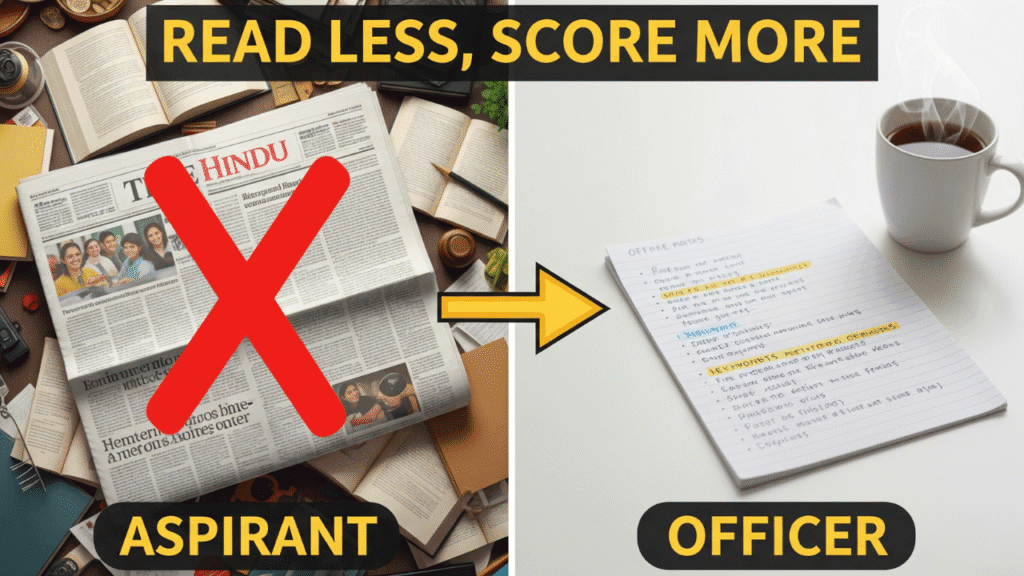
Stop wasting 3 hours every day. This guide provides a strategic framework for effective UPSC newspaper reading, making powerful notes, and linking every news item to the syllabus.
Learning how to read The Hindu for UPSC is the single most important skill in your preparation. It is also the area where most aspirants waste thousands of hours. Many treat the newspaper like a textbook, reading it cover-to-cover and creating bulky, useless notes. This is not just inefficient; it’s a strategic disaster.
The purpose of UPSC newspaper reading is not to become a news expert; it’s to develop an administrative perspective and collect exam-relevant material for your Mains and Interview. This guide will provide you with a 4-step framework to transform your daily reading from a passive, time-consuming chore into a sharp, surgical, and high-ROI activity.
Why Your Current Newspaper Strategy is Failing
If you spend more than 75 minutes on the newspaper, your strategy is likely flawed. The common mistakes include:
- Reading every article, including political statements and local news.
- Focusing on the news itself, not the underlying issue.
- Making notes that are just a copy of the article.
- Failing to link syllabus with current affairs.
This guide on how to read The Hindu for UPSC will fix these mistakes permanently.
The 4-Step Officer’s Framework for Reading The Hindu
Adopt this framework to read with purpose and precision. This is the core of an effective current affairs strategy for UPSC.
Step 1: Syllabus First, Newspaper Second (The Filter)
Never open the newspaper without first having the UPSC syllabus imprinted on your mind. The syllabus is not a document; it is your filter. It tells you what to read and, more importantly, what to ignore.
- Keep a copy of the syllabus on your desk.
- Before reading an article, ask: “Which part of the GS Paper 1, 2, 3, or 4 syllabus does this relate to?”
- If you cannot find a clear link in under 10 seconds, skip the article.
- For a deeper understanding of this, it is crucial to first decode the syllabus itself.
Step 2: Issue-Based Reading (The Focus)
You are not reading about “news”; you are studying “issues.” The news is just an event; the issue is the larger, ongoing topic relevant to the syllabus.
- Example: A news article about a Supreme Court judgment on the powers of the speaker is the news. The issue is the “Separation of Powers” (GS2), the “Office of the Speaker,” and “Judicial Review.”
- Your goal is to extract points that add value to your understanding of the core issue.
- Ignore the he-said-she-said political commentary. Focus on the constitutional, legal, economic, or social dimensions of the issue.
Step 3: The Art of Making The Hindu Notes for UPSC (The Capture)
Your notes should be a weapon, not a liability. The goal is to create concise, revision-friendly material. Follow these rules for making The Hindu notes for UPSC:
- Rule of 50 Words: Summarize the entire crux of the article in 50 words or less. This forces you to identify the core argument.
- Extract, Don’t Copy: Pull out only what you need:
- Keywords & Definitions: Any important term defined (e.g., ‘Monetization of the Deficit’).
- Data/Statistics: From an official source (e.g., NFHS, RBI).
- Arguments: 1-2 points for and 1-2 points against a particular issue.
- Supreme Court/High Court Judgments: The name of the case and the core principle laid down.
- Examples: For use in Ethics (GS4) or Essays.
- Use Digital or A4 Sheets: Organize your notes by syllabus topic (e.g., a specific folder or page for “Federalism”), not by date. This is the most crucial step to link syllabus with current affairs.
Step 4: Connect and Revise (The Integration)
The final step is to integrate these notes with your static knowledge.
- When you study “Federalism” from Laxmikanth, you should immediately open your “Federalism” current affairs notes to see the recent developments.
- This creates a powerful, holistic understanding of the topic.
- This integrated note-making system makes revision exponentially more effective.
Conclusion: Stop Reading, Start Analyzing
Your goal is to spend no more than 60-75 minutes each day on your UPSC newspaper reading. This is achievable only when you shift from being a passive reader to an active analyst. Use the syllabus as your shield, focus on the underlying issues, and make notes that are sharp and integrated.
Mastering how to read The Hindu for UPSC is your first real test in building an administrative mindset—the ability to filter noise, identify importance, and act efficiently. Begin this practice today.








